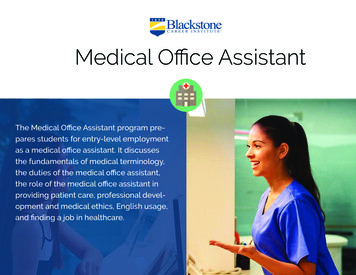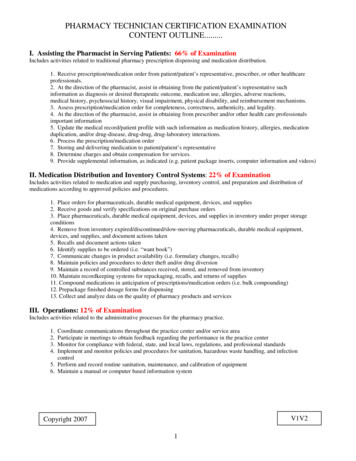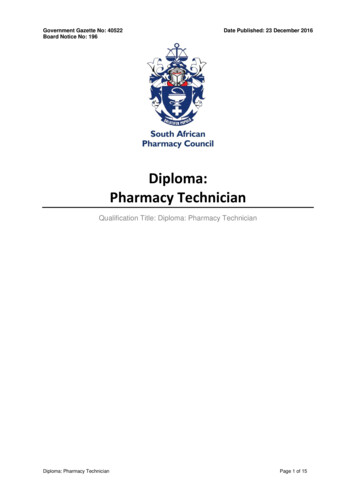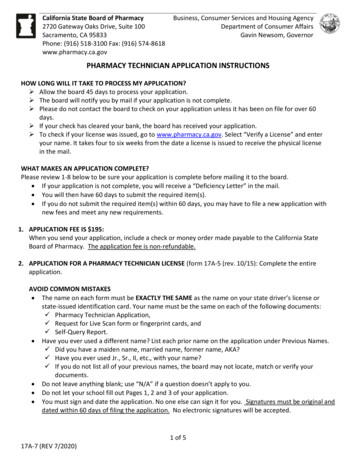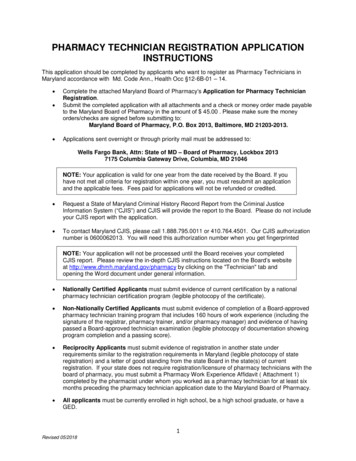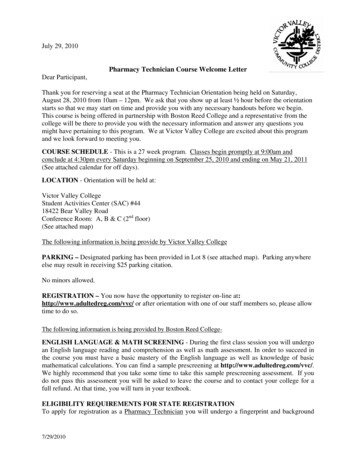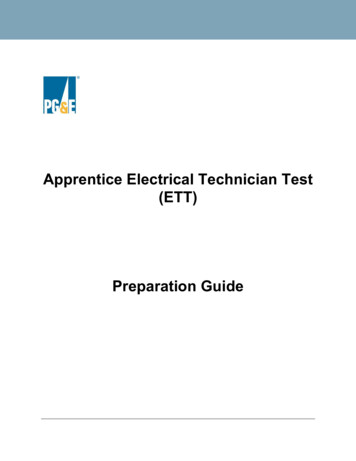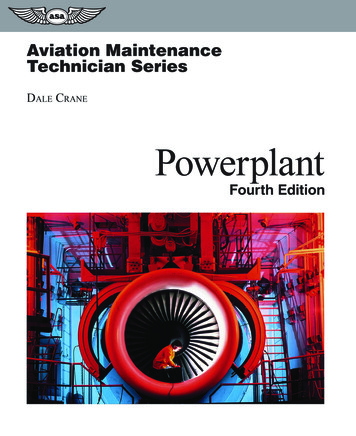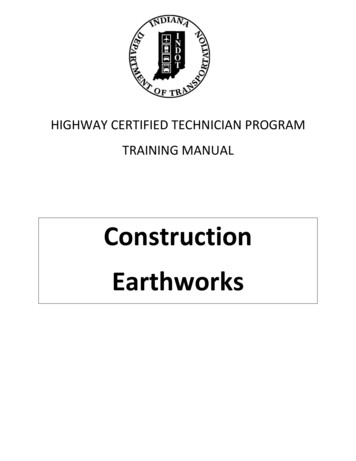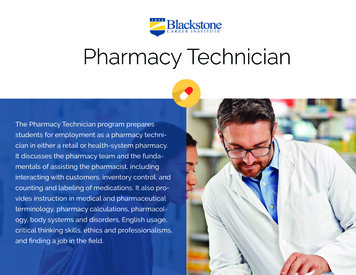
Transcription
Pharmacy TechnicianThe Pharmacy Technician program preparesstudents for employment as a pharmacy technician in either a retail or health-system pharmacy.It discusses the pharmacy team and the fundamentals of assisting the pharmacist, includinginteracting with customers, inventory control, andcounting and labeling of medications. It also provides instruction in medical and pharmaceuticalterminology, pharmacy calculations, pharmacology, body systems and disorders, English usage,critical thinking skills, ethics and professionalisms,and finding a job in the field.
The Pharmacy Technician program preparesstudents for entry-level employment as aPharmacy TechnicianThere are no due-dates for any of your coursework and you have up to 18months to complete your program.To contact your Instructor Andrew, please email instructor@blackstone.edu.Any general questions, please email info@blackstone.edu.Your course is broken down into units. Students who pay in full for their programhave access to all course materials. Students who enroll under a monthly payment plan have access to a new unit every month upon making theirmonthly payment.
The program is broken down into 18 study units.All course material is included in your tuition. Unit 1 - Blackstone’s Skills for Successpg. 1 Unit 2 - Introduction to Computers, Keyboarding and Office Technologypg. 1 Unit 3 - Anatomy and Medical Terminology 1: An Introductionpg. 2 Unit 4 - Anatomy and Medical Terminology 2pg. 2 Unit 5 - English Usage and Written Communicationpg. 3 Unit 6 - Time and Stress Managementpg. 3 Unit 7 - Anatomy and Medical Terminology 3pg. 4 Unit 8 - Anatomy and Medical Terminology 4pg. 4 Unit 9 - Fundamentals of Pharmacy Practicepg. 5 Unit 10 - Community and Instituitional Pharmacypg. 5 Unit 11 - Pharmacy Calculationspg. 6 Unit 12 - Pharmacologypg. 6 Unit 13 - Creating an Effective Workplace Enviornmentpg. 7 Unit 14 - Critical Thinking Skillspg. 7 Unit 15- Body Systems, Diseases and Pharmaceutical Treatmentspg. 8 Unit 16- Special Topics in Pharmacologypg. 8 Unit 17- Professional Development and Medicolegal Ethicspg. 9 Unit 18- How to Find a Job in Healthcarepg. 9
Our graduates are eligible upon completion of theirPharmacy Technician course to sit for nationalcertification through these organizations.Graduates of Blackstone Career Institute’s Pharmacy Technician Training online course qualify tosit for the Exam for the Certification of Pharmacy Technicians (ExCPT) sponsored by the NationalHealthcareer Association (NHA), and the Pharmacy Technician Certification Exam (PTCE) offeredby the Pharmacy Technician Certification Board (PTCB).Our online Pharmacy Technician Program is Nationallyand Regionally Accredited through the DEAC and MSA.It is important to check with the state licensing board orsimiliar regulatory body in the state you plan to work in.
What you receive with your programYour program consists of eighteen units, including the following commercial e-books and electronic resources, to assist youstep-by-step through the program.The Pharmacy Technician: Foundations and Practices by PearsonThis e-book provides clear understanding of the pharmacy technicianprofession including responsibilities, step-by-step directions for performing procedures, basic math and pharmacy calculations practice,and pharmaceutical treatments for common diseases and disorders.You will recieve this e-book with Study Unit 9.Mosby’s Drug Reference for Health Professions and Practices byMosby/ElsevierThis invaluable online reference will give you concise, reliable information on the drugs you will come in contact with in a pharmacysetting. Key details for each drug include drug name, pronunciation,trade name(s), category and schedule, classification, mechanism ofaction, dosages, side effects, precautions and considerations. You willreceive access to this online reference tool with your third lesson.
Program Goals & Objectives Identify common learning strategies Describe how computers, internet and electronic communication impact the workplace today Identify and define common medical prefixes, suffixes, and roots Demonstrate knowledge of guidelines for grammar, punctuation, and written correspondence Apply time mastery and productivity skills in professional and personal settings Define anatomical and pharmaceutical terminology and identify relevant abbreviations Describe the duties of a pharmacy technician Identify the correct way to interact with customers and patients while protecting patient confidentiality Explain the various laws and ethical standards that affect the pharmacy technician Differentiate between retail and health-system pharmacies Identify the forms of technology utilized in the pharmacy setting Describe the process for inventory management and insurance billing Perform relevant pharmacy calculations, including dosage calculations and measurement conversions Discuss dosage formulations and administration, as well as the effects of drugs on the body Identify drug classifications Describe the body systems and related diseases, disorders and treatments Identify the different needs of pediatric and geriatric patients Demonstrate knowledge of proper workplace etiquette Explain the importance of medical ethics Compose effective resumes and cover-letters Consider ways to proactively search for work as a pharmacy technician
Blackstone’s Skills for SuccessUnit 1In this lesson, you will discover how you learn as well as your learning style. You will understandhow you learn best by reading about intrinsic versus extrinsic motivation, field dependence andindependence, self-efficacy and self determination. Visual, auditory, and kinesthetic learners willbe discussed along with the differences between them. You will also receive some tips regardingyour study space, the best time to work, and goal setting. Also, basic keyboarding skills will beintroduced. Learning strategies, along with note-taking and memory tricks, are also an importantpart of this lesson.Introduction to Computers,Keyboarding and Office TechnologyUnit 2Lesson 2 covers how computers are used in the office today, the different types of computers, andthe parts of a computer system. In this lesson you will also learn about the Internet, URLs, searchengines, and e-mail. Office technology will be discussed, including office networks, different typesof servers, PDAs, scanners, digital cameras, and wireless communication.1
Anatomy and Medical Terminology 1:An IntroductionUnit 3This lesson begins your study of medical terminology. The lesson explains how medical terms areconstructed and analyzed to determine meaning; the parts of medical terms, including roots, prefixes, and suffixes; the function of combining vowels; and how terms are pluralized. The lesson alsointroduces the basic organization of the human body and discusses the body cavities, planes ofthe body, and directional terms. You will receive access to the e-book for Mosby’s DrugReference for Health Professions.Anatomy and Medical Terminology 2Unit 4In this lesson, you will study four of the body systems—skeletal, muscular, integumentary (skin),and respiratory—and the relevant medical terms and abbreviations, as well as common injuriesand diseases.2
English Usage and Written CommunicationUnit 5In this lesson, you will gain knowledge about the English language and written communication. This information is important to the successful allied health professional. Begin with parts ofspeech, then review parts of a sentence, pronouns, verbs and finally sentence types and punctuation. This lesson is a great grammar tutorial or refresher. You will also learn about writing in activeversus passive voice, paragraph formation, and topic sentences; and you gain some valuable tipsfor business communication.Time and Stress ManagementUnit 6This lesson discusses how to minimize stress and maximize productivity in your personal and professional life by analyzing your values, habits, and daily interruptions. Multiple worksheets andexercises are included, as well as valuable tips for prioritizing and setting goals.3
Anatomy and Medical Terminology 3Unit 7This lesson covers the anatomy and physiology of the cardiovascular, urinary, digestive, andnervous systems, including the relevant medical terms as well as common diseases, tests andprocedures, and terminology abbreviations.Anatomy and Medical Terminology 4Unit 8This final anatomy and medical terminology lesson completes the study of the body, covering theendocrine and sensory (eyes and ears) systems; the blood, lymphatic and immune systems; andthe male and female reproductive systems. The lesson discusses diseases associated with thesebody systems and also lists common abbreviations for terms related to these systems.4
Fundamentals of Pharmacy PracticeUnit 9This lesson will introduce you to the history and future of pharmacy practice. You will read aboutthe pharmacy professions; various pharmacy settings; characteristics of a good pharmacy technician; and career opportunities. You will learn about the communication process and how to interact with customers and patients. This lesson discusses pharmacy law, regulatory agencies, andethical considerations. Pharmaceutical terminology and abbreviations are also covered. You willreceive access to the e-book: The Pharmacy Technician.Community and Institutional PharmacyUnit 10This lesson introduces health-system and retail pharmacies, their organization, and the roles thatpharmacy technicians play in each. You will learn about technology in the pharmacy, collectinginsurance information and how patient confidentiality applies to electronic data. Inventory management is discussed, including ordering, receiving and returns. Medication compounding, flavoring, and quality assurance are covered. This lesson also explores sterilization, aseptic techniques,equipment and supplies, sterile products and routes of administration.5
Pharmacy CalculationsUnit 11This lesson reviews basic math skills, decimals, fractions, Roman Numerals, ratios andpercentages. You will learn about measurement systems and converting measurements.Important pharmacy calculations, including dosage calculations, concentrations and dilutions,alligations, and parenteral calculations are also covered.PharmacologyUnit 12This lesson covers dosage formulations and routes of administration, as well as medication errors.An overview of the body and drugs, including pharmacodynamics, pharmacokinetics, drugdistribution and metabolism, and drug addiction is discussed. You will also explore the variousdrug classifications.6
Creating an Effective WorkplaceEnviornmentUnit 13Lesson 13 provides an overview of successful workplace strategies, including how the variousroles in the office can function together and how to use feedback, goals and incentives for increasing productivity. This lesson will introduce you to the fundamentals of effective communication,including maximizing your speaking and listening skills and proper use of body language to communicate messages. You will also learn about the benefits of working in a culturally diverse environment, and how to overcome barriers caused by diversity. Finally, this lesson will explore teambuilding strategies.Critical Thinking SkillsUnit 14This lesson helps students develop their critical thinking skills, including use of inference andjudgment, identifying strong conclusions, persuasive strategies, and deductive reasoning. You willalso read about metacognition, the process of thinking about thinking, and how it builds criticalthinking skills, as well as interpreting and using critical theories.7
Body Systems, Diseases andPharmaceutical TreatmentsUnit 15This lesson reviews the different body systems, including diseases and conditions, along withcommon pharmaceutical treatments.Special Topics in PharmacologyUnit 16This final pharmacology lesson discusses pediatric and neonatal patients and the differences intheir medication administration. Common childhood and geriatric diseases are covered, along withpharmaceutical treatments and concerns. You will also read about biopharmaceuticals and thefuture of pharmaceutical research.8
Professional Developmentand Medicolegal EthicsUnit 17In Lesson 17, you will read about professional development and medicolegal ethics. Attitude, selfesteem, professional attire, and grooming are all topics presented in this lesson. Also, business etiquette; verbal and nonverbal communication; proper introductions; and continuing education willbe discussed. You will read about ethics in healthcare, codes of ethics, and the purpose of healthcare records. Important information about making corrections, timeliness, and confidentiality isexplored in this lesson. This lesson also presents the HIPAA guidelines, discussing the Privacy andSecurity Rules, Protected Health Information, access control, deidentified information, and workarea security.How to Find a Job in HealthcareUnit 18This lesson discusses how to get ready for your job search. You’ll learn how to write an effective resumé and cover letter. You’ll learn about the different styles of resumés and the type of languageused on resumés. This chapter also discusses job interviews in detail. You’ll learn how to dress forsuccess on an interview and how to prepare answers to commonly asked questions.9
Pharmacy Technician The Pharmacy Technician program prepares students for employment as a pharmacy techni-cian in either a retail or health-system pharmacy. It discusses the pharmacy team and the funda-mentals of assisting the pharmacist, including interacting with customers, inventory contro
